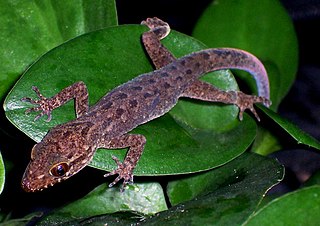
Gonatodes is a genus of New World dwarf geckos of the family Sphaerodactylidae.

Cyrtodactylus is a diverse genus of Asian geckos, commonly known as bent-toed geckos, bow-fingered geckos, and forest geckos. The genus has 354 described species as of 2023, which makes it the largest of all gecko genera.

Quedenfeldtia moerens, known commonly as the Atlas day gecko, is a species of lizard in the family Sphaerodactylidae. The species is endemic to Morocco.

The Atlas day gecko is a species of lizard in the family Sphaerodactylidae. The species is endemic to Morocco.

Saurodactylus brosseti is a species of gecko in the Sphaerodactylidae family found in western Morocco. Both this species and Saurodactylus mauritanicus were both commonly known as the Morocco lizard-fingered gecko, and were both considered conspecific. Its natural habitats are temperate forests, rocky areas, arable land, and pastureland. It is threatened by habitat loss.
Saurodactylus mauritanicus is a species of gecko in the Sphaerodactylidae family found in Morocco, Western Sahara, and possibly Algeria. Both this species and Saurodactylus brosseti were both commonly known as the Morocco lizard-fingered gecko, and were both considered conspecific. Its natural habitats are temperate forests, rocky areas, arable land, and pastureland. It is threatened by habitat loss.
There are two species of gecko named Morocco lizard-fingered gecko:
Coleodactylus elizae is a species of gecko, a lizard in the family Sphaerodactylidae. The species is endemic to Brazil.
Gonatodes nascimentoi is a species of lizard in the family Sphaerodactylidae. The species is endemic to Brazil.
Peters' gecko is a species of lizard in the family Sphaerodactylidae. The species is endemic to Venezuela.

Gonatodes riveroi is a species of lizard in the family Sphaerodactylidae. The species is endemic to Colombia.
Pristurus phillipsii, known commonly as Phillip's rock gecko or the Somali rock gecko, is a species of lizard in the family Sphaerodactylidae. The species is endemic to the Horn of Africa.
The Saudi rock gecko is a species of lizard in the family Sphaerodactylidae. The species is endemic to the Arabian Peninsula.
The coastal rock gecko is a species of lizard in the family Sphaerodactylidae. The species is endemic to Somalia.
Edwin Nicholas Arnold was a British herpetologist and the Curator of Herpetology at the Natural History Museum, London. Arnold made seminal contributions to the herpetology of Europe and North Africa, especially on geckos and lizards of the family Lacertidae. He discovered and described 36 species and 4 subspecies of reptiles, and wrote A Field Guide to the Reptiles and Amphibians of Britain and Europe, which appeared over multiple editions. Arnold died of heart failure on 23 September 2023, at the age of 82.
Saurodactylus slimanii is a species of gecko in the Sphaerodactylidae family found in Morocco.
Saurodactylus splendidus is a species of gecko in the Sphaerodactylidae family found in Morocco.

The Isla Vieques dwarf gecko is a species of lizard in the family Sphaerodactylidae. It is endemic to Vieques and western Culebra in Puerto Rico. Sphaerodactylus inigoi was previously considered a subspecies of Sphaerodactylus macrolepis was but was elevated to full species status based on morphological and molecular data.

The big-scaled dwarf gecko, big-scaled least gecko, or cotton ginner is a species of lizard in the family Sphaerodactylidae. It is endemic to Puerto Rico. Sphaerodactylus grandisquamis was formerly a subspecies of Sphaerodactylus macrolepis but was elevated to full species status using a combination of molecular and morphological data. Sphaerodactylus g. phoberus is no longer considered valid and was synonymized with S. g. grandiquamis.







